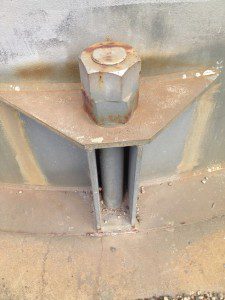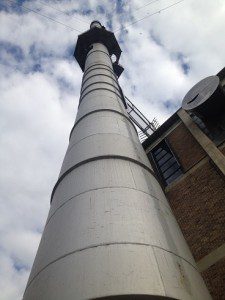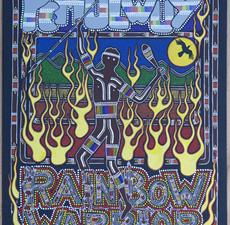 That’s not a bolt, this is a bolt, to steal Paul Hogan’s words in Crocodile Dundee.
That’s not a bolt, this is a bolt, to steal Paul Hogan’s words in Crocodile Dundee.
Hoges was talking about knives, but have a look at the size of this bolt, one of eight giant ones used to lock in the 250 foot stack at Casula Powerhouse. That’s 76 metres for those of you who never learned the old imperial measures.
Very tall by any measure.
The bolts are a metre tall themselves, and that’s just the bit that’s above the concrete slab they go into.
The Liverpool Powerhouse, as it was first known, was built just after World War II in 1951 to supplement electricity production during winter and power shortages.
Originally there were four shorter smoke stacks but after nearby residents complained smoke from the powerhouse dirtied their washing they were pulled down and replaced in 1955 by the stack at the front entrance of what is now the Casula Powerhouse Arts Centre.
The Powerhouse was closed in 1976, and bought by Liverpool Council in 1978 for $75, 000 when Frank Oliveri was mayor.
But nothing happened for a whole decade and the building became derelict.
Finally, in 1985, the council ran a plebiscite and a majority voted for the powerhouse building to be converted into an arts centre.
Two years later – things move really quickly in local government – council appointed two staff members to oversee the first capital works program. Electricity was installed, building reviews carried out and an office space was furnished.
 Six years later, in 1993, while Mark Latham was Mayor of Liverpool, Casula Powerhouse was allocated funding in council budgets for the very first time. An ambitious development took place, and the centre opened its doors in 1994.
Six years later, in 1993, while Mark Latham was Mayor of Liverpool, Casula Powerhouse was allocated funding in council budgets for the very first time. An ambitious development took place, and the centre opened its doors in 1994.
Tomorrow, Saturday, September 12, the winners of the 24th Annual Mil-Pra AECG Exhibition and Art Award will be announced.
The entries will be on exhibition until October 4.
The Mil-Pra is a core component of the Casula Powerhouse Arts Centre’s annual program.
It seeks to inspire us to reflect on and hopefully celebrate the beauty and complexity of Aboriginal and Torres Strait Islander culture.
This year, the theme is ‘Sacred Ground’ and refers to Aboriginal and Torres Strait Islander peoples’ strong spiritual and cultural connection to the land and the surrounding sea. The theme is an opportunity to pay respects to this country and think about how we need to preserve it as it is the root of our culture.
As aspirations go, that’s big – much bigger even the bolts that hold down the 250 smoke stack of the Powerhouse.

